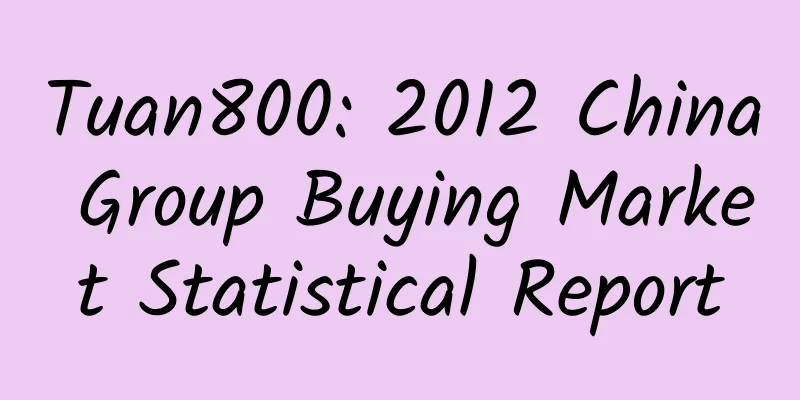Tuan800: 2012 China Group Buying Market Statistical Report

|
On January 16, 2012, the group buying navigation website Tuan800 recently released the "2012 China Group Buying Market Statistical Report". The data showed that based on continuous monitoring of more than ten mainstream group buying websites in China, the total transaction volume in 2012 reached 21.39 billion yuan, a year-on-year increase of 93% over 2011. The total number of purchases throughout the year reached 456 million, an increase of 45% over 2011. Excluding seasonal factors, the two positive results mainly come from the substantial increase in the number of group purchases by merchants throughout the year and the increase in the average price of group purchases. Compared with 2011, the number of group purchases sold by merchants reached a record high of 2.499 million, an increase of 3.7 times over 2011. At the same time, the prices of group purchase products continued to rise, with the average discount rising from 33% in 2010 and 36% in 2011 to 39%. After a year of business model adjustment and refined management, some group buying websites have announced that they have achieved large-scale profits at the end of 2012. The normalization of local service group buying products has also promoted the new vitality of group buying itself towards the mobile Internet platform, and further spawned diversified O2O innovations such as reservation ordering and membership card discounts. Experts pointed out that the concept of group buying entered China in early 2010 and has gone through the first phase of madness in the past three years. It has profoundly influenced consumers' lifestyles with its direct convenience. If we do not separate it from others and look at it in the longer term, we can say that it represents another innovative push by the Internet and information technology to social livelihood since the first round of Internet craze in 2000. Annual performance nearly doubled, but discounts were not as strong as before According to the monitoring of domestic mainstream group buying websites by Tuan800, the transaction volume of domestic group buying in December 2012 reached a historical high of 2.16 billion yuan, while the number of group orders on sale and the number of purchasers in that month also reached 367,000 and 44.12 million for the first time, up 23.9% and 15.8% month-on-month. This is the second time in 2012 that the monthly transaction volume exceeded 2.1 billion yuan (the last time was in August), and it is also the first time that the number of purchasers has been below 40 million for three consecutive months. The increase in December's performance is related to the special environment of that month. The New Year's blockbuster movies, led by "Lost in Thailand", greatly boosted the box office of the month, and also made the increase in group purchase movie tickets unusually obvious. In addition, the cluster of year-end festivals also boosted other group purchases that were suitable for the occasion, such as catering, hot springs, skiing, etc., which all saw significant growth compared to November. While group buying performance is showing a strong momentum of rising tide, we must also be aware that in addition to seasonal bonus factors, the nearly doubling of the overall scale of the group buying industry in 2012 was largely due to the large-scale development and long-term sales of ground merchants by group buying sites. In 2012, they cut back their money-burning brand promotion budgets and instead adopted the business philosophy of "providing more group-buying options" to expand a large number of local merchants, turning them into group-buying options and moving them to their pages, in order to maximize the potential for group-buying consumption among netizens. According to statistics, the number of group purchase orders sold monthly in 2012 was 208,000, a sharp increase from 45,000 in 2011. At the same time, in order to change the long-term low gross profit margin, group purchase sites quietly raised the group purchase price this year, with the average price rising to 39% off, and launched some discount packages with 50% to 80% off to increase their overall profit margin. Correspondingly, consumers' group purchase mentality in 2012 also changed significantly, from rushing to buy and stock up to buying on demand, which gradually changed group purchase from impulsive consumption to rational choice. The joint changes of group buying websites, merchants and consumers have made the domestic group buying industry evolve into a more normalized marketing model. This has also led to many subtle changes in consumers' group buying behaviors. Some people even take out their mobile phones to check whether there are any available group buying discounts after entering a theater or restaurant and place orders on the spot. This also makes the group buying industry seem to see a new dawn brought by mobile Internet at the end of 2012. However, there are two concerns that need to be pointed out: the continued development of the group buying industry in 2013 cannot rely on the method of tapping merchants to issue orders again; how to find specific opportunities (such as movie group buying in December) to increase consumer group buying participation again, so as to break the curse of no more than 40 million monthly purchases. Third- and fourth-tier cities are showing signs of life, and small and medium-sized group-buying sites are struggling to survive In early 2011, after receiving sufficient venture capital, group buying sites rushed to expand into local cities. However, it took some time for the concept of group buying to become popular, and many of them failed, tasting the bitter fruit of overloaded expansion, and subsequently slowed down their expansion into small and medium-sized cities. But the reality is so cruel. In mid-2012, when major group buying websites were closing their branches and adopting a contraction strategy, group buying began to gain popularity in third- and fourth-tier cities. According to the Tuan800 report, in 2012, the total sales in third- and fourth-tier cities reached 9.941 billion yuan, accounting for 46.5% of the total volume. In 2011, these same cities only accounted for less than 20% of the market size. In 2012, the contribution of group buying transactions in the three major cities of Beijing, Shanghai and Guangzhou dropped from 28.3% to 22.9%. The Shanghai market even slightly surpassed the Beijing market that year. The contribution of the eight second-tier cities of Shenzhen, Chengdu, Wuhan, Xi'an, Tianjin, Chongqing, Hangzhou and Nanjing to the national performance dropped slightly from 23.8% in 2011 to 22.5%. Faced with the current situation of the gradual saturation of development in first- and second-tier cities, several national group-buying sites have once again started to move to local areas. However, this time they are well prepared and extremely cautious. They regard these cities as hidden gold mines, and whoever gets a larger share is likely to have the last laugh. Compared with the large group-buying websites that conquered cities and territories, local group-buying websites have been struggling to move forward in the past year, playing a "hunger games". No group-buying website dared to raise prices significantly, because if it was the first to raise prices, it might hand over users to its competitors' websites, further reducing its revenue and accelerating its death. This led to an unstable balance for half a year, and the cash reserves of each company were constantly consumed in the stalemate. The "prisoner's dilemma" in game theory is being played out again and again. Compared with the peak period of more than 5,000 in August 2011, there are only more than 2,000 group-buying websites left in China. If the "quasi-group-buying" websites that point to Taobao online stores are removed again, I'm afraid that a large number of them will flee again after the Spring Festival this year. Large group-buying sites are suppressing each other's gross profit margins due to competition, which has caused many small and medium-sized group-buying sites to lose their bargaining chips with merchants and thus be cleared out of the main arena. In 2012, they collectively flocked to vertical industries with high gross margins, such as wedding photography and surrounding tourism (hot springs, skiing, and suburban tours). In fact, from a certain perspective, they have become indistinguishable from those ticket dealers who specialize in wholesale discounts. The final battle has not yet begun, and the top five stations have obvious advantages Compared with Groupon's dominance in the United States, which accounts for nearly 80% of the market share, the domestic group buying market also showed a trend of centralization in 2012. If the ranking of the top ten group buying sites in 2012 is compared with that in 2011, the scale advantage of the top ten first-tier group buying sites has continued to increase. In 2012, the total transaction volume of the top ten group buying sites was 19.84 billion yuan, accounting for 92.8% of the annual group buying transaction volume. In 2011, the figure was 87.6%. What is more noteworthy is that in 2012, not only did the top 10 list change (24quan disappeared, Ftuan merged with Gaopeng), but the combined share of the top five group buying websites in 2012 was as high as 74.5%, while the combined share of the top five in 2011 was 55.8%. The transaction volume of group-buying websites at the top of the pyramid continued to concentrate, and the "Matthew effect" was further intensified. In the second half of 2012, there was even a vacuum zone with monthly transaction volume of 100 million to 200 million yuan between the top five group-buying websites. Compared with 2011, the top ten group buying websites in 2012 also underwent significant changes. According to statistics, the transaction volume of the top five group buying websites in 2012 exceeded 2 billion yuan, of which Meituan and Dianping exceeded 3 billion yuan, and the next five were all around 1 billion yuan; Compared with last year's list, 24quan has long disappeared from the overall ranking. Gaopeng.com, which is backed by Tencent, will launch a new impact after merging with Ftuan. The top three have also changed from Lashou, Meituan, and Wowotuan in 2011 to Meituan, Dianping, and Wowotuan today. The large players in China's group buying industry each rely on their parent company's resources, and the competition between them will continue for quite a long time. Perhaps they can eventually find a reasonable ratio for each other in the ever-expanding market. Transformation and innovation of group buying and competition and cooperation between e-commerce platforms In 2012, as competition intensified, many group-buying sites were wavering in their direction: should they stick to local service group buying with an average gross profit margin of less than 8%, or use their existing user base to transform into online group buying? For the latter, the cost of ground sales staff will be greatly reduced for group-buying sites. Many group buying websites abandoned local services and completely transformed into physical group buying in 2012, and the entire industry is also hovering at this crossroads pointing to the future. According to data as of the end of 2012, out of the total transaction volume of 21.39 billion yuan, the total sales of local service products amounted to 19.24 billion yuan, accounting for 89.9%. The sales of online shopping products were only 2.16 billion yuan, accounting for only about 10% of the total, and a quarter of the volume in 2011. This means that the efforts of group buying websites to transform into physical group buying have achieved little success, and they eventually fell on the development focus of local service group buying. In fact, when group buying websites transform into online shopping, they also have to face the preparation of building their own warehousing and logistics after becoming bigger, as well as the biggest challenge - consumers' online shopping habits. Compared with the more mature group buying platform Juhuasuan, these mainstream group buying websites seem to be far behind in terms of the power of online group buying. According to the group buying data released by Juhuasuan in 2012, its annual transaction volume reached 20.75 billion. Hu Chen, a consumer expert and co-founder of Tuan800, analyzed that there is a benign complementarity between group buying complex platforms such as Juhuasuan and JD.com and group buying websites such as Meituan and Dianping.com, with slight overlap and respective strengths. This is like the two wings of a butterfly, each with its own advantages and development focus in local services and online group buying. Although there is overlap, the distinction is very obvious, and they will jointly improve the domestic Internet group buying ecosystem. From the recent joining of several independent group buying websites into the Juhuasuan and JD platforms, we can see that the large platforms of e-commerce websites are still an irresistible temptation for group buying sites that are still struggling to survive. Compared with 2011, group buying websites have lost their dazzling halo. With vicious competition, cold market, failed IPO, lack of capital, layoffs and closures, the group buying industry went through many ups and downs in 2012. The industry persisted in the torment and sought change in survival. 2012 did not end China's group buying industry. These immature websites, which are less than three years old, seem to have just found the courage and wisdom to survive. Recently, several group buying websites have announced their profits, which has given the industry and the public a shot in the arm. This fantastic adventure has also made them more eager to survive than ever before, and has also made the development blueprint of the entire O2O industry gradually clear. |
<<: Market Metrix: What factors influence customers’ choice of hotel?
>>: Taobao data: 2012 Taobao New Year Market Report
Recommend
Can "eating dirt" cure enteritis? What kind of weird linkage is this?
Recently, a new research result published in Natu...
[Smart Agriculture Diagram] One picture reveals the secret! How safe are genetically modified foods?
...
Crazy! People who don’t have cats are starting to pick up Hericium erinaceus!
People who want to pet cats but can’t get them ar...
The efficacy and function of fine-leaved calendula
Fine-leaved Calendula is a relatively familiar tr...
The efficacy and function of purple flower incense
In modern life, everyone is very familiar with va...
iVend Retail: More than 80% of Internet users have used “buy online, pick up in store”
According to a survey by iVend Retail, 40% of con...
The difference between determining secondary close contact and high screening may be just the distance of a mask?
Recently, the number of sporadic asymptomatic inf...
Mobile group buying behavior on mobile phones and tablets
“When we are not shopping, we are on the way to s...
The efficacy and function of Veronica ciliata
Do you know Veronica ciliata? It is a common Chin...
Why does covering your ears make your own speech louder?
In daily life I wonder if you have noticed a stra...
What are the functions and effects of dandelion
We all know dandelion flowers, but I believe many...
The disadvantages of chasing yellow grass
Ganhuangcao is a traditional Chinese medicinal ma...
Technical tips! "Ya Ya", "Meng Lan", "Hua Hua"... How to distinguish who is who among so many pandas?
After about 16 hours of flight, the cargo plane c...
If the whole of China was a class - in Gansu, all the classmates would be wearing the same clothes!
Students who have been to Gansu, can you guess wh...









